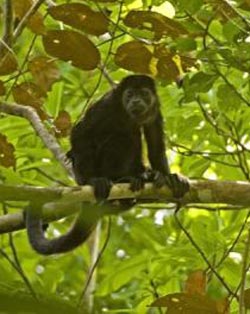Tropical arks reach tipping point

Even well-protected tropical reserves may not protect wildlife if the surrounding habitat is degraded. This howler monkey lives on Barro Colorado Island, a Smithsonian research station in the Panama Canal waterway.<br><br>Credit: Smithsonian Tropical Research Institute<br>
“Biodiversity is declining rapidly at reserves including Kahuzi Biega in the Democratic Republic of Congo, Xishuangbanna in southern China, and Northern Sierra Madre in the Philippines, among others,” said Laurance. “Reserves that are doing relatively well include Bwindi Impenetrable N.P. in Uganda, Santa Rosa in Costa Rica, and Los Amigos in Peru.”
Laurance asked experts who study plant and animal life across the Americas, Africa and Asia-Pacific to rate the effectiveness of the reserves where they have worked over the last two to three decades. Smithsonian coauthors include STRI staff scientist Joe Wright, and John Kress, Mercedes Foster and Louise Emmons at the National Museum of Natural History. They rated reserve health based on changes in abundance of 31 different groups from trees to primates.
“Reserves are like arks for biodiversity,” said Laurance, “But some are in danger of sinking.”
Even well-protected reserves mirror changes in surrounding landscapes. On the Smithsonian's Barro Colorado Island research station in Panama researchers recorded slight increases in exotic animals and plants.
Reserves suffering the most were those were encroached upon by illegal colonists, hunters and loggers. The bottom line, researchers say, is that we need to do a better job of protecting protected areas.
The Smithsonian Tropical Research Institute, headquartered in Panama City, Panama, is a unit of the Smithsonian Institution. The Institute furthers the understanding of tropical nature and its importance to human welfare, trains students to conduct research in the tropics and promotes conservation by increasing public awareness of the beauty and importance of tropical ecosystems. Website: www.stri.si.edu.
Reference: Laurance, William F., and 215 coauthors. 2012. Averting biodiversity collapse in tropical forest protected areas. Nature, DOI:10.1038/nature11318. Published online on 26 July 2012.
Media Contact
All latest news from the category: Life Sciences and Chemistry
Articles and reports from the Life Sciences and chemistry area deal with applied and basic research into modern biology, chemistry and human medicine.
Valuable information can be found on a range of life sciences fields including bacteriology, biochemistry, bionics, bioinformatics, biophysics, biotechnology, genetics, geobotany, human biology, marine biology, microbiology, molecular biology, cellular biology, zoology, bioinorganic chemistry, microchemistry and environmental chemistry.
Newest articles

Making diamonds at ambient pressure
Scientists develop novel liquid metal alloy system to synthesize diamond under moderate conditions. Did you know that 99% of synthetic diamonds are currently produced using high-pressure and high-temperature (HPHT) methods?[2]…

Eruption of mega-magnetic star lights up nearby galaxy
Thanks to ESA satellites, an international team including UNIGE researchers has detected a giant eruption coming from a magnetar, an extremely magnetic neutron star. While ESA’s satellite INTEGRAL was observing…

Solving the riddle of the sphingolipids in coronary artery disease
Weill Cornell Medicine investigators have uncovered a way to unleash in blood vessels the protective effects of a type of fat-related molecule known as a sphingolipid, suggesting a promising new…





















